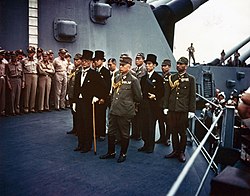Toshikazu Kase
Toshikazu Kase | |
|---|---|
Kamakura, Japan | |
| Nationality | Japanese |
| Occupation | Diplomat |
Toshikazu Kase (加瀬 俊一, Kase Toshikazu, January 12, 1903 – May 21, 2004) was a Japanese civil servant and career diplomat. During World War II he was a high-ranking Foreign Ministry official. Hideaki Kase is his son and Yoko Ono is his niece.

Biography
Kase was born in
He had a son, Hideaki Kase, [1936-2022] who became a diplomatic critic in promoting Japanese WWII historical revisionism books and films.
He took up diplomatic posts in both
On September 2, 1945, Kase was present as part of the Japanese delegation on board USS Missouri for the signing of the treaty of surrender in 1945.[4] At his suggestion Foreign Minister Mamoru Shigemitsu and other civilian members of the party wore formal diplomatic attire of morning dress and top hats "because we were representing our sovereign" (an exception to this was Saburo Ota, who wore no hat and whose white suit contrasted with other civilian members' mostly black morning dress). Kase had drafted the English text of the document accepting the terms of the Potsdam Declaration.[1]
Kase continued to work in the Foreign Ministry until 1948 when he left to practice journalism. In 1950 Kase published a book that gave an account of the war from a Japanese perspective.[4]
Resuming his diplomatic career in 1954, Kase took up an appointment as chief advisor to the same foreign minister whom he had assisted at the surrender ceremony on board the USS Missouri. In 1955 he became Japan's first ambassador to the United Nations.[5] His final diplomatic posting, before retiring in 1960, was as ambassador to Belgrade.[1]
Kase was interviewed in English for the 1970s documentary series The World at War.
Kase died, aged 101 years, in
See also
- Shun'ichi Kase, Japanese diplomat whose name is spelt with the same characters as Toshikazu's
- Japanese nationalism
References
- ^ a b c d Obituary in "The Telegraph" of June 3, 2004
- ^ USS Missouri.com
- ^ Brooke, James. (November 8, 2003) "Toshikazu Kase: A Japanese Witness to History Adroitly Survived It", The New York Times.
- ^ ISBN 0-208-00747-4 Synopsis from Digital Library for Nuclear Issues Archived June 6, 2011, at the Wayback Machine
- ^ Britannica Book of the Year 2005
- ^ Obituary: "Toshikazu Kase, 101, Japanese Diplomat". New York Times, June 2, 2004, p 10 NYT Archive
- ^ Pearson, Natalie Obiko, "Toshikazu Kase, Japanese Diplomat in War, Peace". Chicago Sun-Times, June 1, 2004.
Other sources
- Toshikazu Kase at IMDb
- Journey To The Missouri at the Internet Archive
- Daily Telegraph obituary at the Wayback Machine (archived November 11, 2013)
